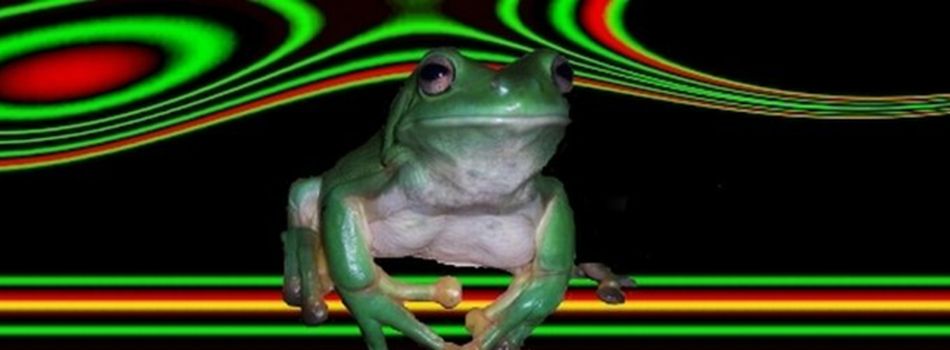Welcome to a pictorial account of our Green Tree Frog Breeding Season.
On these pages you will find a diary of the first five days in the life of a green tree frog. the events summarise the green tree frog development of the first eggs laid for the season. Follow their extraordinary life cycle. See them change or undergo metamorphosis from eggs to tadpoles to froglets and finally frogs. Metamorphosis is the term given to the formation stages that occur as a tadpole develops and becomes a frog.
Day 1: The first eggs of the season are laid in the early morning. Five pairs have been involved and produced over 2000 eggs.
Mating pair of green tree frogs Male and female green tree frogs in amplexus and about to enter the water to lay eggs.
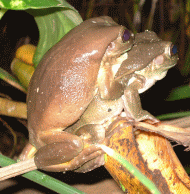

Left: One of the mating pairs. The two green tree frogs are in amplexus. Dad is holding mum from behind and under her armpits. Fertilization of a frog’s eggs is external with the male stimulating the release of the

female’s eggs by grasping her around her body in a grip known as amplexus. At the moment the female releases her eggs, the male deposits sperm into the water to fertilise them. Spawn is the term used to describe the fertilised eggs and the jelly that surrounds them.
Only hours old: Green Tree Frog eggs attached to a water plant. Green tree frogs spawn their eggs in clumps/sheets that float. As the eggs are sticky, they will also attach to plants and rocks in the pond.

12 hour old Green Tree Frog fertilised eggs. Note they have changed from round balls to alien looking forms with definite shape and contours. The egg sac around them is still clearly visable. They are about 2-3 mm long. Water temperature 29C. By about 20 hours the egg sac is absorbed/broken down and the eggs start to sink. They will be free swimming tadpoles within the next 12 hours.
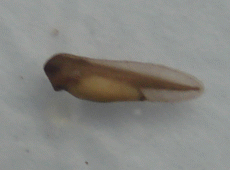
Day 2: The green tree frog eggs have now absorbed their egg sac and dispersed into the water. Tadpoles are the larval form of the frog. There are two names associated with this larvae: tadpole, which means toad’s head, and pollywog, which means wiggling head.
24 hour old green tree frog tadpole. See the stomach area – this is being absorbed and is their first foodDay old tadpoles. The spiracle is obvious in the top tadpole.Green tree frog tadpoles. They don’t move much 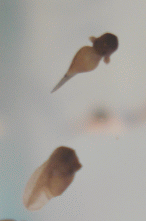 to start with and look as if they just hang in the water
to start with and look as if they just hang in the water
The tadpoles are now 5 mm long and look more like a tadpole. Water temperature 30C. Note the stomach area – the last of the y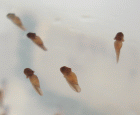 olk – their food storage for the first few days of life. This adaptation helps give them a good start in the green tree frog life cycle. This too will be absorbed quickly and they will then eat using their mouthparts which comprise of a pair of half-moon shaped structures called a horny beak. This enables them to chop up food. The tadpoles also have a series of more superficial rows of black, comb-like, labial teeth which act as scrapers. You can also see the tiny gill like structures on their heads through which water is discharged. It is termed a spiracle.
olk – their food storage for the first few days of life. This adaptation helps give them a good start in the green tree frog life cycle. This too will be absorbed quickly and they will then eat using their mouthparts which comprise of a pair of half-moon shaped structures called a horny beak. This enables them to chop up food. The tadpoles also have a series of more superficial rows of black, comb-like, labial teeth which act as scrapers. You can also see the tiny gill like structures on their heads through which water is discharged. It is termed a spiracle.
The tadpoles at this stage keep still, but will wriggle and dart around occasionally. You can see them swim by clicking on the button below.
Day 3: The green tree frog tadpoles are off and swimming!

At 72 hours they look more like the classic tadpoleBy day 3 the tadpoles tails has grown and they now swim proficientlyCan you see the tadpole’s eye’s, mouth, and side fins?
The tadpoles are now 8 mm long and a lot 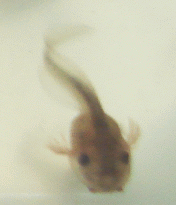 more active than the day before. Water temperature 30C. You can see that their tail has grown longer and they now have the distinct tadpole body, mouth, eyes, fins and tail. It’s time to start introducing the tadpoles to food. We supply fish food flake and our own home grown green algae. We will be transfering the tadpoles later today into larger 20-50L holding tanks with aged water, alage and water plants.
more active than the day before. Water temperature 30C. You can see that their tail has grown longer and they now have the distinct tadpole body, mouth, eyes, fins and tail. It’s time to start introducing the tadpoles to food. We supply fish food flake and our own home grown green algae. We will be transfering the tadpoles later today into larger 20-50L holding tanks with aged water, alage and water plants.
Day 4: The green tree frog tadpoles have now been introduced to fish food flake, water plants and algae.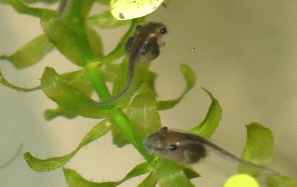
The tadpoles now swim freely and explore everything in search of food. They are now about 10 mm long and 2-3 mm wide. We have already got water on standby to do water changes and will keep a close eye on water quality. Water readings: pH 6.5-7.0, GH 120 mg/L, KH 80 mg/L, NH4+/NH3 0 mg/L, NO2- 0 mg/L and NO3- 0 mg/L. Feed small amounts of algae and flake twice daily. As Green tree frog tadpoles prefer still water we hold off using filters and aerators for as long as possible. Tadpoles will eat their own faeces hence another reason not to filter the water too well!
Day 5: The tadpoles have grown a little more and now swarm as soon as the fish food flake and algae are supplied.
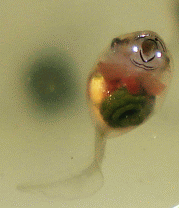
The green tree frog tadpole above shows their horny beak and the rows of black labial teeth. Tadpoles are primarily herbivores and they have a long coiled intestine to digest their food. They will also eat some protein in the form of insects that fall into the water etc. That’s why we also supply fish food flake and not just plant and algae. They are now 11-12 mm long and about 3 mm at their widest body.
